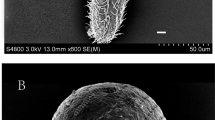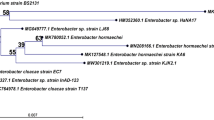Abstract
Entamoeba histolytica forms chitin-walled cysts during encystation process, where formation of the cyst wall needs not only chitin synthase but also chitinase. During excystation, quadruplet amoebae emerge from the chitin-walled cysts by dissolving the wall, so that chitinase may be necessary for excystation process as well. There is, however, no report on chitinase expression during excystation. In this study, we used Entamoeba invadens, a reptilian amoeba, as a model for encystation and excystation of E. histolytica, and studied chitinase mRNA expression in those processes. Although expression of three E. invadens chitinases designated EiChit1, EiChit2, and EiChit3 during encystation has been reported, we identified another enzyme named as EiChit4 in the E. invadens genome database. Therefore, we investigated the primary structure and mRNA expression of these four chitinases of Ei in the excystation as well as the encystation by real-time reverse transcription polymerase chain reaction (RT-PCR). Like EiChit1, EiChit4 had an 8 × Cys chitin-binding domain (CBD) and a hydrophilic spacer between the CBD and catalytic domain, and was also closer to EiChit1 than EiChit2 and EiChit3 in the phylogenetic tree. During encystation, the expression of all four chitinases increased in the early phase; the increase in EiChit1 and EiChit4 was much higher than in EiChit2 and EiChit3. Then, the expression of all four chitinases sharply decreased in the later phase. In cysts, EiChit1 was most abundantly expressed and EiChit4 was at a lower level, while the expressions of EiChit2 and EiChit3 were virtually absent. Following the induction of excystation, mRNA levels of EiChit1 and EiChit4 in cysts 5 h after induction were significantly lower than those in cysts before induction, while those of EiChit2 and EiChit3 were remarkably higher than before induction. The mRNAs of only EiChit2 and EiChit3 remarkably increased when the excystation was induced in the presence of cytochalasin D. These data demonstrate different structures and expressions of four chitinases in the differentiation of E. invadens.




Similar content being viewed by others
References
Arroyo-Begovich A, Carbez-Trejo A, Ruiz-Herrera J (1980) Identification of the structural component in the cyst wall of Entamoeba invadens. J Parasitol 66:735–741
Beintema JJ (1994) Structural features of plant chitinases and chitin-binding proteins. FEBS Lett 350:159–163
Campos-Góngora E, Ebert F, Willhoeft U, Said-Fernández S, Tannich E (2004) Characterization of chitin synthases from Entamoeba. Protist 155:323–330
Chatterjee A, Ghosh SK, Jang K, Bullitt E, Moore L, Robbins PW, Samuelson J (2009) Evidence for a “wattle and daub” model of the cyst wall of Entamoeba. PLoS Pathog 5:e1000498
Chávez-Munguía B, Cristóbal-Ramos AR, González-Robles A, Tsutsumi V, Martinez-Palomo A (2003) Ultrastructural study of Entamoeba invadens encystation and excystation. J Submicrosc Cytol Pathol 35:235–243
Das S, Gillin FD (1991) Chitin synthase in encysting Entamoeba invadens. Biochem J 280:641–647
de la Vega H, Specht CA, Semino CE, Robbins PW, Eichinger D, Caplivski D, Ghosh S, Samuelson J (1997) Cloning and expression of chitinases of Entamoebae. Mol Biochem Parasitol 85:139–147
Dey T, Basu R, Ghosh SK (2009) Entamoeba invadens: cloning and molecular characterization of chitinases. Exp Parasitol 123:244–249
Diamond LS, Harlow DR, Cunnick CC (1978) A new medium for the axenic cultivation of Entamoeba histolytica and other Entamoeba. Trans R Soc Trop Med Hyg 72:431–432
Eichinger D (1997) Encystation of entamoeba parasites. BioEssays 19:633–639
Felsenstein J (1985) Confidence limits on phylogenies: an approach using the bootstrap. Evolution 39:783–791
Frisardi M, Ghosh SK, Field J, Van Dellen K, Rogers R, Robbins P, Samuelson J (2000) The most abundant glycoprotein of amebic cyst walls (Jacob) is a lectin with five cys-rich, chitin-binding domains. Infect Immun 68:4217–4224
Ghosh SK, Field J, Frisardi M, Rosenthal B, Mai Z, Rogers R, Samuelson J (1999) Chitinase secretion by encysting Entamoeba invadens and transfected Entamoeba histolytica trophozoites: localization of secretory vesicles, endoplasmic reticulum, and Golgi apparatus. Infect Immun 67:3073–3081
Ghosh SK, Frisardi M, Ramirez-Avila L, Descoteaux S, Sturm-Ramirez K, Newton-Sanchez OA, Santos-Preciado JL, Ganguly C, Lohia A, Reed S, Samuelson J (2000) Molecular epidemiology of Entamoeba spp.: evidence of a bottleneck (demographic sweep) and transcontinental spread of diploid parasites. J Clin Microbiol 38:3815–3821
López-Romero E, Villagómez-Castro JC (1993) Encystation in Entamoeba invadens. Parasitol Today 9:225–227
Makioka A, Kumagai M, Ohtomo H, Kobayashi S, Takeuchi T (2001) Entamoeba invadens: enhancement of excystation and metacystic development by cytochalasin D. Exp Parasitol 98:145–151
Makioka A, Kumagai M, Kobayashi S, Takeuchi T (2005) Entamoeba invadens: cysteine protease inhibitors block excystation and metacystic development. Exp Parasitol 109:27–32
Makioka A, Kumagai M, Kobayashi S, Takeuchi T (2009) Involvement of serine proteases in the excystation and metacystic development of Entamoeba invadens. Parasitol Res 105:977–987
Makioka A, Kumagai M, Hiranuka K, Kobayashi S, Takeuchi T (2010) Entamoeba invadens: identification of ADF/cofilin and their expression analysis in relation to encystation and excystation. Exp Parasitol 127(1):195–201
Nielsen H, Brunak S, von Heijne G (1999) Machine learning approaches for the prediction of signal peptides and other protein sorting signals. Protein Eng 12:3–9
Page RD (1996) TreeView: an application to display phylogenetic trees on personal computers. Comput Appl Biosci 12:357–358
Saitou N, Nei M (1987) The neighbor-joining methods: a new method for reconstructing phylogenetic trees. Mol Biol Evol 4:406–425
Sakuda S, Isogai A, Matsumoto S, Suzuki A, Koseki K (1986) The structure of allosamidin, a novel insect chitinase inhibitor produced by Streptomyces sp. Tetrahedron Lett 27:2475–2478
Sanchez L, Enea V, Eichinger D (1994) Identification of a developmentally regulated transcript expressed during encystation of Entamoeba invadens. Mol Biochem Parasitol 67:125–135
Suzuki K, Taiyoji M, Sugawara N, Nikaidou N, Henrissat B, Watanabe T (1999) The third chitinase gene (chiC) of Serratia marcescens 2170 and the relationship of its product to other bacterial chitinases. J Biochem 343:587–596
Thompson JD, Higgins DG, Gibson TJ (1994) CLUSTALW: improving the sensitivity of progressive multiple sequence alignment through sequence weighting, position-specific gap penalties and weight matrix choice. Nucleic Acids Res 22:4673–4680
Van Dellen K, Ghosh SK, Robbins PW, Loftus B, Samuelson J (2002) Entamoeba histolytica lectins contain unique 6-Cys or 8-Cys chitin-binding domains. Infect Immun 70:3259–3263
Van Dellen K, Chatterjee A, Ratner DM, Magnelli PE, Cipollo JF, Steffen M, Robbins PW, Samuelson J (2006) Unique posttranslational modifications of chitin-binding lectins of Entamoeba invadens cyst walls. Eukaryot Cell 5:836–848
Villagómez-Castro JC, Calvo-Mendez C, López-Romero E (1992) Chitinase activity in encysting Entamoeba invadens and its inhibition by allosamidin. Mol Biochem Parasitol 52:53–62
Wright CS (1989) Comparison of the refined crystal structures of two wheat germ isolectins. J Mol Biol 209:475–487
Yamagami T, Funatsu G (1996) Limited proteolysis and reduction-carbomethylation of ryc seed chitinase–α- role of the chitin-binding domain in its chitinase action. Biosci Biotechnol Biochem 60:1081–1086
Acknowledgments
We thank N. Watanabe for his valuable discussion with us and T. Harada for her technical assistance.
Author information
Authors and Affiliations
Corresponding author
Rights and permissions
About this article
Cite this article
Makioka, A., Kumagai, M., Hiranuka, K. et al. Different structure and mRNA expression of Entamoeba invadens chitinases in the encystation and excystation. Parasitol Res 109, 417–423 (2011). https://doi.org/10.1007/s00436-011-2270-2
Received:
Accepted:
Published:
Issue Date:
DOI: https://doi.org/10.1007/s00436-011-2270-2




